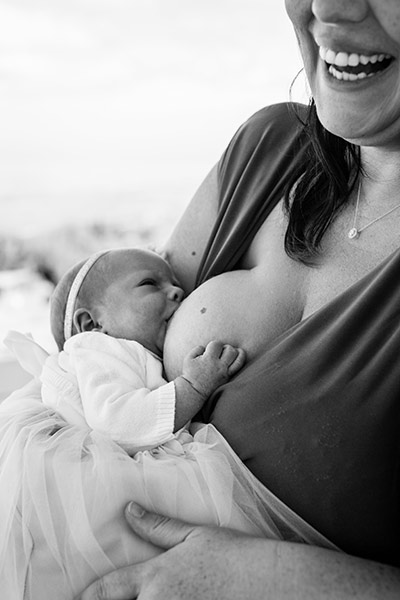Breastfeeding is amazing. Being a new mom is amazing. Your newborn baby is amazing. The learning curve of it all is…overwhelming. Especially when it comes to the basics like sleep and breastfeeding.
While sleep is a whole other topic, here are 5 myths about breastfeeding to keep in mind when thinking about your short term and long-term breastfeeding goals.
Myth #1: Your boobs will fill up when you have enough milk.
When your milk first comes in shortly after baby is born, your breasts can become quite large and engorged. This leads a lot of new moms to believe that this sensation is the “norm” for what it feels like when you have enough milk. Not so. Lactating breasts produce milk at all times, so there is milk present whether they look like it from the outside or not. Supply is like a river constantly flowing rather than a glass that gets emptied and refilled; your river of milk is constant.
Your breasts can feel quite “flat” or just maintain a normal-for-you size and still be making milk. A better way to judge milk supply is how many wet diapers baby is making in a day. What goes in must come out…and one way to measure the in/out is through diapers.
Myth #2: What you pump is what you are producing.
Sometimes baby will eat and eat and eat…leaving a mom feeling like she must not be making enough milk if baby just keeps coming back for more. (This can simply be a sign of cluster feeding). But worried moms often reach for their pump to check output and get…1 oz. (cue the tears and thoughts that you’re starving the baby, not making enough, not good enough, biggest fears, lack of sleep, all the negative feels, sob, sob, sob).
Been there…more than once. And all I can think is: that damn pump. It can be such a liar. Pumps have their place and can be extremely helpful – they just don’t get any credit as a true indicator of milk supply.
Rest easy, mama. What you are able to pump is NOT an indication of how much milk you are producing. Babies and pumps extract milk in very, very different ways. The best way to gauge production is through diaper output. Don’t let anyone tell you that you aren’t making enough milk unless they have specifically tested to see how much baby is eating in a feeding. A lactation consultant is one of the few professionals who will do this for you. They weigh baby before a feed, baby nurses, when baby is done they put her back on the scale. The weigh difference is what baby has eaten. Reach out to a lactation consultant if you can’t shake your concerns about production. Absolutely go with your gut.
Myth #3: If your kid has teeth, you should wean.
The fact that some babies are born with teeth blows this myth out of the water. When a baby or toddler has a correct latch, teeth aren’t involved. Biting is a very, very normal part of a baby’s development. Most babies test it out. It’s our job to teach them not to do this. Like most lessons, it’s not one they can or will learn on their own. They need our gentle guidance. If teeth are bothering you, correct the latch. If baby is biting, teach them not to…for your sake and theirs.
Your baby could start teething as early as two months. Some biting behaviors can emerge as teeth start to come in because of all the sensation they are feeling in their mouths and gums. Know this stage is coming and that it’s your job to teach them that “we don’t bite.” Try not to put too much emphasis on teeth in relation to your breastfeeding goals. Tooth growth is all over the map and has very little to do with correct positioning when breastfeeding.

Myth #4: If your child can ask for it, they shouldn’t be nursing.
Babies ask for milk from day one through cries, facial expressions, hand gestures, and rooting. Crying is asking—it’s a basic form of communication. Some babies ask for milk or to nurse as early as 6 months through sign language. My children had a word for nursing at 10 months. Asking is normal, healthy, and simply a form of communication. Back and forth communication is an essential component of breastfeeding.
Myth #5: Breastfeeding is only for “babies”.
We can just go ahead and let go of this unnecessary and unhealthy social stigma. Breastfeeding is absolutely for children under and over 12 months. The World Health Organization recommends moms nurse until a minimum of 2 years of age—that’s a minimum, not a maximum. There is so much nutritional value in milk even after the age of one. It’s also a social norm around the world. It’s okay to breastfeed until you are comfortable…and it’s okay if that comfortable level goes outside someone else’s.
Thanks for understanding that this is not intended to be medical advice. I am not a medical professional, just a mom who has been breastfeeding for over 4.5 years straight and cares about other moms. My goal is to support other mamas on their breastfeeding journey. Please contact a lactation consultant with further concerns or questions.

